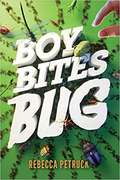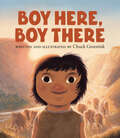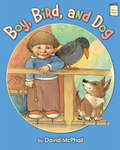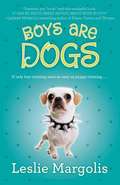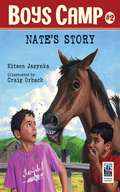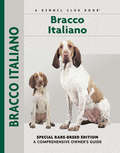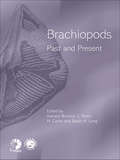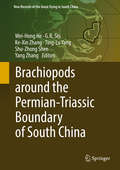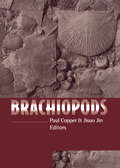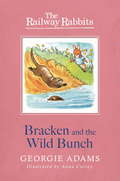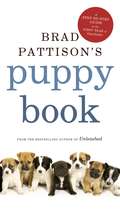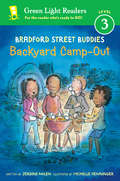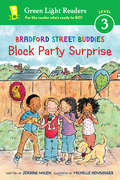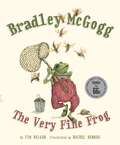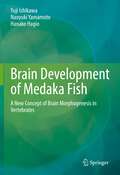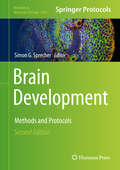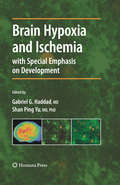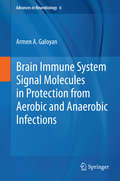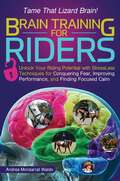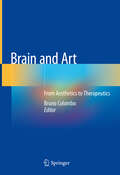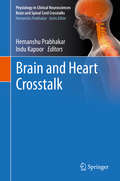- Table View
- List View
Boy Bites Bug
by Rebecca PetruckWill didn’t plan to eat a stinkbug. But when his friend Darryl called new kid Eloy Herrera a racial slur, Will did it as a diversion. Now Will is Bug Boy, and everyone is cracking up inventing insect meals for him, like French flies and maggot-aroni and fleas. Turns out eating bugs for food is a real thing called entomophagy. Deciding that means he can use a class project to feed everyone grasshoppers, Will bargains for Eloy’s help in exchange for helping him with wrestling, but their growing friendship only ticks off Darryl more. Will may have bitten off more than he can chew as crickets, earthworm jerky—even a scorpion—end up on his plate, but insects are the least of his problems. When things between Darryl and Eloy heat up, Will wrestles with questions of loyalty and honor—and learns that maybe not all friendships are worth fighting for.
Boy Here, Boy There
by Chuck GroeninkTo a young Neanderthal boy, the world is full of incredible adventures — and unexpected encounters, when he meets a human boy for the first time in this stunning, sparsely worded picture book.A prehistoric Neanderthal family arrives at their new home, a cave, after a long journey. But their young boy's imagination is seized by the beauty and promise of the valley below, and he sets out to explore all that the valley has to offer along, with his place in it. This wild, prehistoric world is full of beauty and wonder, including big and little "hairies" (woolly mammoths). But across a river, the boy spots another boy, a Homo sapiens. He's dressed differently, but so much else is the same. The two share a moment of recognition before the stranger and his family depart, leaving a lasting impression on the Neanderthal boy — one that will have effects reaching throughout history.This picture book, sparingly written and expansively illustrated, imagines an encounter between Homo sapiens and our Neanderthal cousins based on the expanding understanding of prehistoric peoples. It will inspire young readers to see the beauty in discovery and the natural wonders of the prehistoric world as well as our shared humanity.Includes back matter with information about prehistoric life and Neanderthals as well as a bibliography.
Boy, Bird, and Dog (I Like to Read)
by David McPhailDavid McPhail celebrates ingenuity, creativity, and friendship in this picture book created especially for the newest reader. Boy and Bird can go up to the tree house, but Dog cannot. Boy has an idea. Using a rope and a pot, the boy is able to pull the dog up the tree to a vantage point where the three friends can observe all good things in the world—including Mom bearing a plate of cookies. David McPhail's poignant characters express intelligence, joy, and the affectionate bond of friendship. Together they live in a world that is wondrous, safe, and happy. An I Like to Read® book. Guided Reading Level D.
Boy, Were We Wrong About Dinosaurs!
by Kathleen V. Kudlinski S. D. SchindlerThe ancient Chinese thought dinosaurs were magical dragons. Some old-time scientists thought that because they were so big, all they could do was float in water. Boy, were they wrong! This lively book about the perennially popular subject of dinosaurs offers fascinating insight into how certain theories were formed, and then how those theories were proved or disproved. It demonstrates that scientific thought is as creative as it is logical and invites budding scientists to come up with their own ideas.
Boy: An Ozark Coon Hound
by S. P. MeekYoung Greg Oliphant moved to the peace and quiet of the Ozark Mountains in an attempt to rebuild his war-shattered nerves. He bought an old cabin and a coon hound, and found companionship and help in old Uncle Fred McHarney. This is the heartwarming story of the two men, how they built a new hope and future for Greg, and, in the process, trained a young coon hound to become champion of them all
Boys Are Dogs
by Leslie MargolisWhen her mother gets a new boyfriend, sixth-grader Annabelle gets to cope with a new town, a new school, and a new puppy and, while training her puppy, she decides to apply some of the same techniques to tame the unruly boys that are making her middle-school life miserable.
Boys Camp: Nate's Story
by Craig Orback Kitson JazynkaNate has returned to Camp Wolf Trail, his own personal heaven for the past two summers, with a secret: He doesn't want his cabinmates to know that he's a Bird Nerd. At least, that's what the kids at his school called him when they teased him about his newly found interest in birds. Nate confides in Vik, but can he trust his friend, the cabin jokester? Tension grows when before an overnight horse-riding trip Nate discovers that he has another secret. He is terrified of horses, even Herschel, the boney old horse assigned to Nate from the group of rescue horses that the campers ride.Nate shows honesty and bravery when he faces his fears--both of being laughed at for his hobby and his apprehension of riding horses. His friends and his sense of humor save him when his secret is revealed without his consent. But what will Nate do when a wildfire threatens the safety of his friends, the horses, and himself while on a horseback trek deep in the forest? What will be the fate of homely Herschel, the horse no one wants to adopt? With profound admiration of nature, honesty, and above all, boy-friendly, lively humor, acclaimed author Kitson Jazynka and veteran illustrator Craig Orback catch and capture readers' eager interest in this exciting book for boys.
Bracco Italiano
by Juliette CunliffeOne of Italy's most ancient gun-dog breeds, the Bracco Italiano is a celebrated pointing dog prized for its versatility and working ability. As this Comprehensive Owner's Guide reveals, the Bracco is also an exceptional companion dog that makes an intelligent and affectionate family pet. The history chapter is followed by a chapter devoted to the characteristics of this Continental hunting breed, offering sound advice about which owners are best suited to this vigorous and active canine.New owners will welcome the well-prepared chapter on finding a reputable breeder and selecting a healthy, sound puppy. Chapters on puppy-proofing the home and yard, purchasing the right supplies for the puppy as well as house-training, feeding, and grooming are illustrated with photographs of handsome adults and puppies. In all, there are over 135 full-color photographs in this useful and reliable volume. The author's advice on obedience training will help the reader better mold and train into the most well-mannered dog in the neighborhood. The extensive and lavishly illustrated chapter on healthcare provides up-to-date detailed information on selecting a qualified veterinarian, vaccinations, preventing and dealing with parasites, infectious diseases, and more. Sidebars throughout the text offer helpful hints, covering topics as diverse as historical dogs, breeders, or kennels, toxic plants, first aid, crate training, carsickness, fussy eaters, and parasite control. Fully indexed.
Brachiopods (Systematics Association Special Volumes Ser.)
by Howard Brunton L. Robin M. Cocks Sarah M. LongThe growth history of a brachiopod is entombed in its shell, but research on fossil and living brachiopods has generated unanswered questions about these marine invertebrates. Several contributors to Brachiopods Past and Present comment on their differing structures and morphological detail. They use these as examples of ontogenetic and evolutionar
Brachiopods around the Permian-Triassic Boundary of South China (New Records Of The Great Dying In South China Ser.)
by Yang Zhang Wei-Hong He G. R. Shi Ke-Xin Zhang Ting-Lu Yang Shu-Zhong ShenBrachiopods: The O/s Extinction Recovery Fauna (Special Papers In Palaeontology Ser. #No. 74)
by Paul CopperThis collection of conference papers presents information on the molecular genetics, biomineralization, growth and ecology of extant brachiopod stocks (extrapolated back to the Cambrian), and the shell microstructure, taphonomy, paleogeography, evolution, and taxonomy of fossil brachiopods.
Bracken and the Wild Bunch: Book 11 (Railway Rabbits Ser.)
by Georgie AdamsMeet the Railway Rabbits! Join the irrepressible Longears family as they get in and out of scrapes, meet new friends, and perform daring rescues. But Burdock the buzzard and the terrifying Red Dragon, are always on the lookout for naughty rabbits who stray too far from home...Fun and games for Bracken when he meets some mischievous otters who play havoc along the riverbank. Heartwarming, hilarious, with Anna Currey's charming illustrations, this is a brilliant new animal adventure series from a best selling children's author.
Brad Pattison's Puppy Book: A Step-By-Step Guide to the First Year of Training
by Brad PattisonCanine behaviourist, dog advocate and bestselling author Brad Pattison is back with his essential guide for all things puppy. From choosing the right breeder and your pup's first days with your family to street safety, chew training, grooming and bathing, Brad Pattison's Puppy Book covers pretty much everything a new dog owner needs to know. While Unleashed covered Pattison's basic training philosophies and how to correct negative behaviour, this book will ensure that you get things started on the right foot, and will keep those negative habits from forming later in life. With his proven canine communication techniques and safe, effective training methods, you don't have to be a fan of one of his shows to realize that Pattison's innovative approach stands out from the pack. He teaches you how to recognize and work with your puppy's needs, so that you can effectively communicate and bond with them. Pattison knows that there's no such thing as one-size-fits-all when it comes to dog training, and puppies everywhere will be better off if their owners buy this book.
Bradford Street Buddies: Backyard Camp-Out (Green Light Readers Level 3)
by Jerdine Nolen Michelle HenningerThe backyard camp-out is tonight. Jada and Jamal Perkins have never slept in a tent before. Neither have their best friends, Carlita Garcia and Josh Cornell. Camping is going to be so much fun. Or is it? It's really dark in the backyard. And what's that noise? It's coming from the bushes.CRUNCH! CRUNCH! CRUNCH! SCRUNCH! SCRUNCH! SCRUNCH! Will an unexpected visitor ruin the Bradford Street Buddies camp-out under the stars? Grab a flashlight and find out in this new Level 3 easy reader series.
Bradford Street Buddies: Block Party Surprise (Green Light Readers Level 3)
by Jerdine Nolen Michelle HenningerWelcome to the neighborhood! Join twins Jada and Jamal, and their best friends, Carlita and Josh, for Bradford Street's fall block party. Beginning and newly independent readers are in for a surprise of prehistoric proportions as they explore this fun-filled multicultural neighborhood brimming with community spirit.
Bradley McGogg, the Very Fine Frog
by Tim Beiser“Eww! What is that? Such horrible stew!Orange-colored roots that were sticky with goo. . . .”Bradley McGogg makes his home in the bog where there are plenty of yummy bugs for a frog to feed on. Upon finding his pantry bare one day, Bradley decides to meet his neighbors, in the hopes that they will share some of their favorite meals with him. But this “bog frog” soon finds that not all animals eat alike . . . .
Brahmin and the Ungrateful Tiger (Rigby PM Plus Non Fiction Ruby (Levels 27-28), Fountas & Pinnell Select Collections Grade 3 Level Q)
by Alan HorsfieldWhen a Brahman priest rescues a tiger from a cage is shocked when the ungrateful beast threatens to eat him. The tiger argues that there is no reason why he shouldn't eat the Brahman, because, "Humans are the most ungrateful creatures on Earth!" The Brahman be for his life, and the tiger agrees to spare him - but only he can find a witness who doesn't believe that all human are ungrateful.
Braiding Manes and Tails: A Visual Guide to 30 Basic Braids
by Charni LewisGive your horse a gorgeous look! Charni Lewis provides step-by-step instructions for 30 mane and tail braids for both casual outings and specialized events of all riding styles. Full-color photographs and detailed illustrations bring every twist and turn to life, while also clearly demonstrating proper hand positioning. Get inspired and experiment with a Scalloped mane braid or a Four-Strand Weave for the tail. Not only will your horse look great, the time you spend braiding will help develop that special bond between you and your horse.
Brain Development of Medaka Fish: A New Concept of Brain Morphogenesis in Vertebrates
by Yuji Ishikawa Naoyuki Yamamoto Hanako HagioThis book describes the developmental process of the brain of the medaka fish. It aims to understand the brain structure of vertebrates, including humans, by taking the brain of the medaka fish as an example and showing its actual developmental process. From developmental and evolutionary viewpoints, the understanding of the brain proceeds from simple to complex structures. Fish retain the basic form of vertebrates, and their brain morphology is relatively simple. Therefore, the fish brain is useful in understanding the brain structure. This book is unique for describing the entire process of the brain development in a specific fish. In addition, the book introduces the readers to a new concept of “Hourglass of Brain Morphogenesis”, concerning the general rule of brain morphogenesis in vertebrates. The authors propose that the brain morphology is highly conserved at the middle developmental stage but diverges more extensively at earlier and later stages. The new concept challenges the accepted theory that has been widely shared for about 200 years since K. von Baer (1828, 1837) and K. von Kupffer (1906) who proposed that three primary brain vesicles at earlier developmental stages develop into five secondary brain vesicles at later developmental stages in all vertebrates. The book provides a basic understanding of the vertebrate brain and is useful for all readers who wish to understand the complex structure of the brain.
Brain Development: Methods and Protocols (Methods in Molecular Biology #2047)
by Simon G. SprecherThis book provides a thorough introduction to widely used techniques for the study of the intersection between developmental biology and neuroscience, an exceptional area to address and investigate impacting biological questions. The fully updated volume examines cutting-edge techniques on a representative range of animals, including widely used genetic model systems, such as the fruit fly, zebra fish, chicken, and mouse, as well as non-canonical experimental systems opened up through the advent of genome editing. Written for the highly successful Methods in Molecular Biology series, chapters include introductions to their respective topics, lists of the necessary materials and reagents, step-by-step, readily reproducible laboratory protocols, and tips on troubleshooting and avoiding known pitfalls. Authoritative and up-to-date, Brain Development: Methods and Protocols, Second Edition is an ideal guide for researchers interested in utilizing recent technical advances in molecular genetics for the study of the brain.
Brain Hypoxia and Ischemia: With Special Emphasis On Development (Contemporary Clinical Neuroscience)
by Gabriel G. Haddad Shan Ping YuBrain Hypoxia and Ischemia explores the various aspects of cell death and survival that are crucial for understanding the basic mechanisms underlying brain hypoxia and ischemia. Chapters focus on a panorama of issues including the role of ion channels/transporters, mitochondria and apoptotic mechanisms, the roles of glutamate/NMDA, mechanisms in penumbral cells and the importance of intermittent hypoxia and gene regulation under these stressful conditions. The volume explores findings from both mammalian and invertebrate model systems and their applicability to human systems and diseases. Careful consideration is also given to differences in hypoxia and ischemia across development. This volume aims to increase the understanding of these mechanisms and to stimulate research on better diagnosis and treatment of diseases that afflict the brain and potentially other organs when O2 levels are dysregulated. Brain Hypoxia and Ischemia is designed for neuroscientists, clinicians and medical/graduate students for use in both basic research and clinical practice.
Brain Immune System Signal Molecules in Protection from Aerobic and Anaerobic Infections (Advances in Neurobiology #6)
by Armen A. GaloyanProline-rich polypeptides - in particular (PRP-1) galarmin and its structural analogues - are, when isolated from the neurosecretory granules of neurohypophysis of humans and animals, a new type of hypothalamic peptides. They work against aerobic, anaerobic, gram-positive, and gram-negative microorganisms in vivo, and do not have etiotropic properties. They are unique and capable substitutes to antibiotics, and, moreover, may be effective against strains, such as MRSA, that develop resistance to antibiotics. Galarmin, a component of the brain neuroendocrine system produced by the neurosecretory cells of hypothalamus, possesses immunomodulative, neuroprotective, antioxidant, antitumorigenic and hematopoietic properties. Moreover, galarmin and its structural analogues are powerful anti-inflammatory compounds. In addition to presenting a full overview of the neuroimmune system, it emphasizes the antibacterial, neuroprotective, and neuroregenerative properties of proline-rich polypeptides. It investigates the mechanism of galarmin's action during different infectious processes, where it targets such dangerous pathogens as Bacillus anthracis, Clostridium perfringens, Mycobacterium tuberculosis, and Methycillin resistant Staphylococcus aureus. This research is important from both a theoretical and a clinical point of view, creating new prospects for the modern pharmaceutical industry and neuroendocrine, neuroimmunological sciences. Dr. Galoyan is a pioneer of the specialized field of neuroimmunology. During his 45-year long career, he has discovered a neuroendocrine immune system of the brain and identified a new type of brain cytokines: proline-rich polypeptides. The most important of these, PRP-1 (galarmin) has been shown to possess antibacterial properties and protect from certain neurotoxins.
Brain Training for Riders
by Andrea Monsarrat WaldoDid you know there is an area of your brain known as the Lizard Brain that thinks only about the immediate moment and your means of survival? Yes, in certain circumstances, your Rational Brain can effectively shut down and you are at the mercy of a reptile...dry-mouthed, sweating, queasy, unable to think clearly—even though you know better. When does the Lizard Brain run the show? It can happen in any number of unfamiliar, uncomfortable, challenging, or stressful riding situations. But here's the thing: with the right kind of training, you can learn to manage the reptile within, which leads to greater confidence with horses, better riding performance, and ultimately, happiness at the barn, at shows, and everywhere in between. Andrea Waldo teaches you how to:Handle uncomfortable emotions, such as fear, anger, anxiety, and embarrassment.Hone your mental game and focus your riding time to get the most out of your hours in the saddle.Care for your emotional injuries the same way you would care for an injured horse.Produce a state of Focused Calm and tap into the skills you have (whether you know it or not!) to ensure an outstanding ride.
Brain and Art: From Aesthetics to Therapeutics
by Bruno ColomboThis book analyzes and discusses in detail art therapy, a specific tool used to sustain health in affective developments, rehabilitation, motor skills and cognitive functions. Art therapy is based on the assumption that the process of making art (music, dance, painting) sparks emotions and enhances brain activity. Art therapy is used to encourage personal growth, facilitate particular brain areas or activity patterns, and improve neural connectivity. Treating neurological diseases using artistic strategies offers us a unique option for engaging brain structural networks that enhance the brain’s ability to form new connections. Based on brain plasticity, art therapy has the potential to increase our repertoire for treating neurological diseases. Neural substrates are the basis of complex emotions relative to art experiences, and involve a widespread activation of cognitive and motor systems. Accordingly, art therapy has the capacity to modulate behavior, cognition, attention and movement. In this context, art therapy can offer effective tools for improving general well-being, quality of life and motivation in connection with neurological diseases. The book discusses art therapy as a potential group of techniques for the treatment of neurological disturbances and approaches the relationship between humanistic disciplines and neurology from a holistic perspective, reflecting the growing interest in this interconnection.
Brain and Heart Crosstalk (Physiology in Clinical Neurosciences – Brain and Spinal Cord Crosstalks)
by Hemanshu Prabhakar Indu KapoorThis book discusses the underlying mechanisms connecting the brain and heart. The physiology of the brain is such that it is easily affected by any altered physiology of other systems, which in turn may compromise cerebral blood flow and oxygenation. Together, the brain and heart control our body systems, allowing them to function automatically. This interaction between the brain and other systems makes it important for us to understand how any kind of injury to the brain can produce complications in remote organs or systems, such as the heart. The central nervous system is responsible for vegetative function and is central to homeostasis. Further, central nervous system responses are linked to the ongoing function of other organ systems e.g. feeding, thermoregulation, reproduction and muscle activity. It is therefore logical that neural control of the cardiovascular system must also interact with the neural control of other organ systems. This book explains in detail stressed cardiac conditions, discussing the pathophysiology and proposed treatment, and also describing lesser-known crosstalks between the acutely or chronically affected brain and heart.
